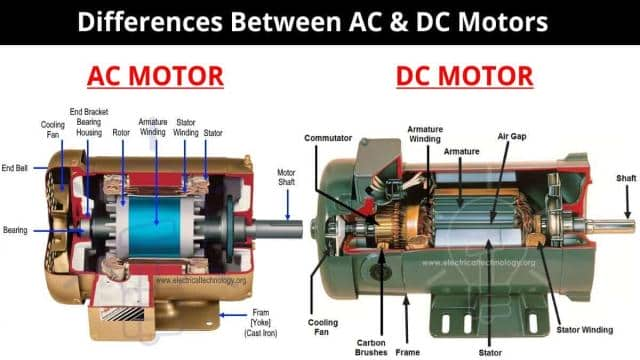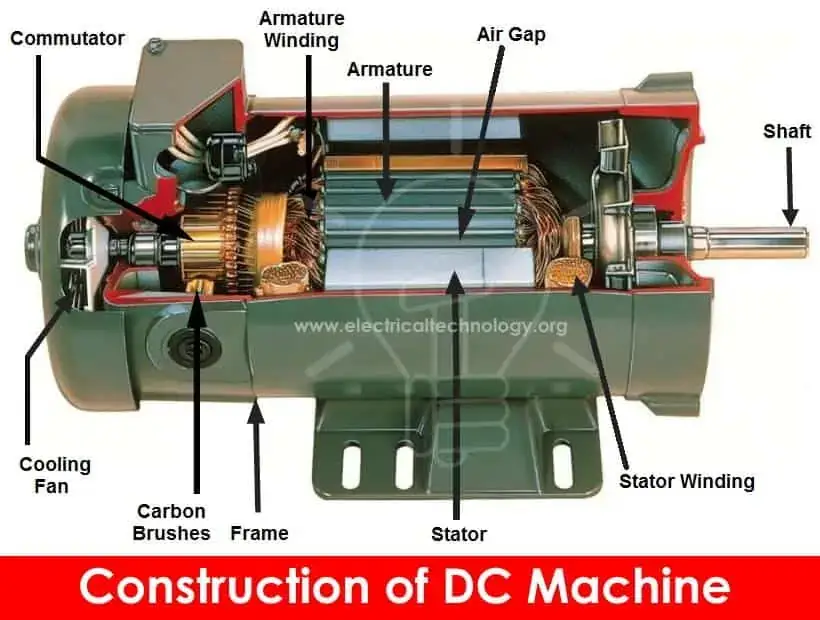Have you ever wondered what makes an electrical machine tick? How does it convert electrical energy into mechanical energy and vice versa? Well, my friends, it’s all thanks to motors! But did you know that there are two main types of motors: AC motors and DC motors? In this article, we’ll take a closer look at the differences between these two powerhouses. So buckle up and let’s dive in!
Main Difference Between AC & DC Motor
AC motors and DC motors may both generate mechanical energy, but their construction, control, efficiency, and applications are quite different.
Before we delve into the list of differences, let’s quickly go over how motors work and the basics of AC and DC motors.
What is an AC Motor?
An AC motor is a type of electrical machine that converts AC electrical energy into mechanical energy. There are two types of AC motors: asynchronous (induction) motors and synchronous motors.
In an asynchronous or induction motor, the stator is made of multiple windings, while the rotor (either squirrel cage or wound type) consists of closed loops of conductors. The stator is supplied with AC, generating an alternating flux known as a rotational magnetic field. According to Faraday’s law of induction, this magnetic flux induces a current in the rotor, which opposes the magnetic field and starts rotating in its direction. Thus, the induction motor operates based on electromagnetic induction between the stator and rotor.
In a synchronous motor, a separate DC supply is sent to the rotor through slip rings to generate its own magnetic field, or a permanent magnet is used. The stator is supplied with AC to generate a rotational magnetic field. The rotor’s magnetic field locks with the stator’s rotational magnetic field and starts rotating at the exact same speed. Since the rotational magnetic field depends on the input AC frequency, the speed of the motor is solely determined by the frequency. Hence, it is called a synchronous motor.
What is a DC Motor?
A DC motor is a type of electrical machine that converts DC electrical energy into mechanical energy. It operates based on the following principle: when a current-carrying conductor is placed in a magnetic field, it experiences a mechanical force perpendicular to both the magnetic field and the current direction. The direction of this force is determined by Fleming’s left-hand rule.
The armature of a DC motor consists of multiple conductor windings placed inside a housing with a permanent magnet that generates the magnetic field. The armature carries the direct current supplied by a DC power source, such as batteries. The magnetic field interacts with the armature’s current-carrying conductors, resulting in a mechanical force.
In a brushed DC motor, the input is applied to the moving part (rotor) of the motor. Carbon brushes and a commutator are used to supply alternating current to the armature. However, they require frequent maintenance as the brushes and commutator wear out over time, decreasing efficiency and generating noise.
On the other hand, in a brushless DC (BLDC) motor, the stator is made of multiple coils surrounding the rotor armature, which is composed of permanent magnets. The DC input is converted into three-phase AC using thyristors and supplied to the stator coils, generating a rotating magnetic field. Since the input is applied to the stationary part (stator), brushes and commutators are not required. This design improves the motor’s performance and efficiency.
Now that we understand the basics, let’s examine the key differences between AC and DC motors.
Key Differences Between AC and DC Motors
- An AC motor converts AC electrical energy into mechanical energy, while a DC motor converts DC electrical energy into mechanical energy.
- AC motors can be asynchronous (induction) motors or synchronous motors, whereas DC motors can be brushed DC motors or brushless DC (BLDC) motors.
- AC motors are powered by alternating current (AC), while DC motors are powered by unidirectional direct current (DC).
- AC motors can be single-phase or three-phase, whereas DC motors are single-phase with positive and negative input lines.
- AC motors do not require commutation since the input supply to the armature is AC. In contrast, DC motors require commutation to convert DC input into AC.
- In AC motors, the armature is always stationary (stator), while in DC motors, the armature rotates (rotor) in brushed DC motors or remains stationary in BLDC motors.
- AC motors do not require carbon brushes, as the input is supplied to the stator. However, DC motors need carbon brushes and a commutator since the input is supplied to the rotor.
- AC motors generate less noise and operate smoothly, while DC motors produce noise and sparks due to the sliding brushes.
- AC motors offer increased output power, while DC motors provide a wide range of speed control.
- The input supply for AC motors can be single-phase or three-phase AC mains, while DC motors require a DC power source such as batteries or solar panels.
- AC motor speed is controlled by varying the input frequency using variable frequency drives (VFD). In contrast, DC motor speed is controlled by varying the armature current, with pulse-width modulation (PWM) being a common method.
- AC motors require less maintenance and are cost-effective, while DC motors require frequent and costly maintenance, making them more expensive than AC motors.
- AC motors have a rotating magnetic field while the armature remains stationary, while DC motors have a stationary magnetic field while the armature rotates.
- Torque decreases with an increase in speed in AC motors, whereas DC motors provide a constant torque over a wide range of speeds.
- AC motors have relatively low efficiency due to induction current losses, whereas DC motors have high efficiency since the magnetic field is generated by a permanent magnet.
- Not all AC motors are self-starting and may require external equipment to start, whereas all DC motors are self-starting.
- AC motors are widely used in domestic and industrial sectors for applications such as drill machines, water pumps, fans, washing machines, and blowers. DC motors are used in applications requiring precise position control and high torque, such as lifts, cranes, conveyor belts, and small motors in embedded electronics and toys.
In conclusion, AC motors are favored for their excellent output power performance, reliability, and low maintenance requirements. On the other hand, DC motors are preferred for their ease of speed control and direction. However, their frequent maintenance can be quite costly. Overall, using a variable frequency drive (VFD) with an AC motor can provide a less expensive solution to achieve the desired results.
So there you have it, my friends! The differences between AC and DC motors have been demystified. I hope this article has shed some light on these powerful machines and helped you understand their unique characteristics. Until next time, keep exploring the fascinating world of electrical machines!
Related Posts:
- Difference Between Single Phase & Three Phase Induction Motor
- DC Machine – Construction, Working, Types and Applications
- Speed Control of DC Motor – Voltage, Rheostatic & Flux Control Methods
- Single-Phase Induction Motor – Construction, Working, Types & Applications
- Three-Phase Induction Motor – Construction, Working, Types & Applications
- What is Motor Starter? Types of Motor Starters and Motor Starting Methods
- Direct Online Starter – DOL Starter Wiring Diagram for Motors
- Difference between AC Drives and DC Drives




